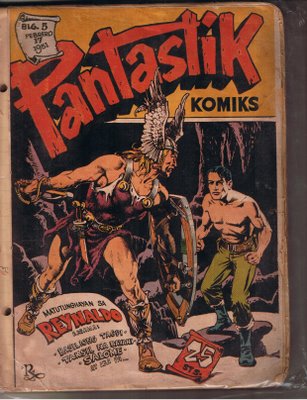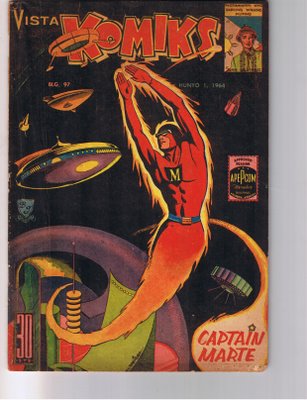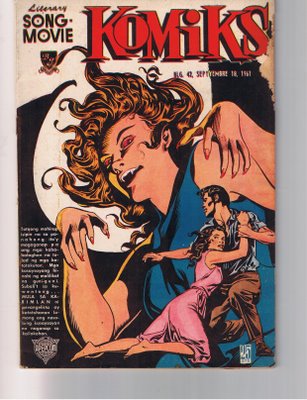 Bing Bigotilyo is Francisco V. Coching's first cartoon character. It first appeared in the Silahis Magazine in late 1930s, was censored during the Japanese occupation, and continued after the war. Although Coching was more well known for his serious comic art, which by the way influenced generations of Philippine comics artists, yet unknown to many, he started out his career as a cartoonist in the Silahis Magazine. His style of cartooning was different from the style of Tony Velasquez or Francisco Reyes, but more in the vein of style by Mauro Malang and Romeo Tabuena.
Bing Bigotilyo is Francisco V. Coching's first cartoon character. It first appeared in the Silahis Magazine in late 1930s, was censored during the Japanese occupation, and continued after the war. Although Coching was more well known for his serious comic art, which by the way influenced generations of Philippine comics artists, yet unknown to many, he started out his career as a cartoonist in the Silahis Magazine. His style of cartooning was different from the style of Tony Velasquez or Francisco Reyes, but more in the vein of style by Mauro Malang and Romeo Tabuena.I happen to keep an extant, although badly damaged original of Bing Bigotilyo from the 1930s. Yet this in itself is a proof of Coching superior cartooning technique, as well as his hilarious sense of humor.
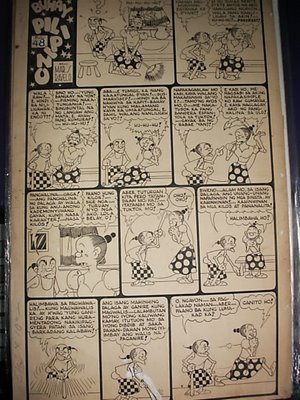
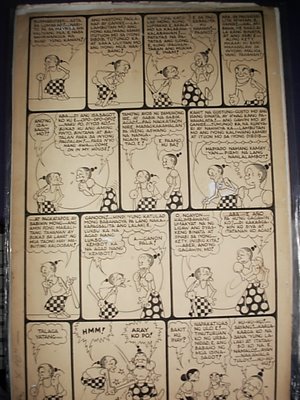 Mars Ravelo's BUHAY PILIPINO may well be the master's greatest work, and for a reason. It was Ravelo's most popular and enduring work. I really think that Ravelo was at the height of his writing prowess when he created Buhay Pilipino. It was more than a comic strip, it reflected the very life of the typical Filipino family of those golden years. More than any other cartoon strip, Ravelo manifested his deep knowledge of sociology and psychology in Buhay Pilipino.
Mars Ravelo's BUHAY PILIPINO may well be the master's greatest work, and for a reason. It was Ravelo's most popular and enduring work. I really think that Ravelo was at the height of his writing prowess when he created Buhay Pilipino. It was more than a comic strip, it reflected the very life of the typical Filipino family of those golden years. More than any other cartoon strip, Ravelo manifested his deep knowledge of sociology and psychology in Buhay Pilipino. Even Ravelo's former critic, the veteran writer Clodualdo del Mundo, was forced to admit that "Buhay Pilipino" amused him. "Ravelo's writing is admirable, his Tagalog is deep, and he has a great sense of humor".. "Buhay Pilipino" satirized Philippine life during the 1940s and the 1950s. The older generation of Filipinos will never forget its immortal characters Tekla, Gorio, Lola Belay, the spinster Kety, and a whole lot of others that Ravelo added to its roster as it made its success through the hearts of the Filipinos. Quite simply put BUHAY PILIPINO is a tour de force. If you can find an old copy of the Liwayway containg this strip, you will see what I mean.
When Ravelo left the Liwayway to concentrate on his own comic publishing, he could not bring with him his Buhay Pilipino because of legal reasons. It was continued under different titles by other writers like Pat Justimbate (who was a student of Mars Ravelo) and Andres Cristobal Cruz. The above featured originals are the only two known extant originals of Buhay Pilipino from the 1951 series.
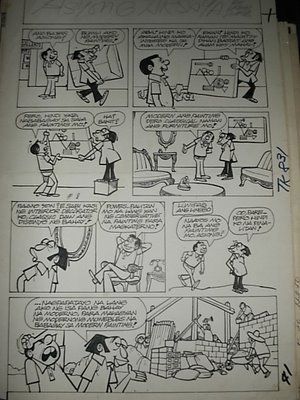 One of Larry Alcala's most famous cartoon characters, Asyong Aksaya dubuted in the Tagalog Komiks in the 1970s. It was later adapted into a movie starring Chiquito in the extravagant title role.
One of Larry Alcala's most famous cartoon characters, Asyong Aksaya dubuted in the Tagalog Komiks in the 1970s. It was later adapted into a movie starring Chiquito in the extravagant title role. Perhaps no other duo in Philippine cartoon history is more memorable than Larry Alcala's Kalabog en Bosyo, who debuted in the Pilipino Komiks in 1947 under the original title ANG KALABOG and the now famous byline "Kalambogesyones ni Larry". Made into several movie adaptations, kalabog en Bosyo is our everyday fumbling detectives who solves the crimes.....accidentally. Other duos that have been partially influenced by Kalabog en Bosyo include Bert Sarile's Ping at Pong and Max en Jess.
Perhaps no other duo in Philippine cartoon history is more memorable than Larry Alcala's Kalabog en Bosyo, who debuted in the Pilipino Komiks in 1947 under the original title ANG KALABOG and the now famous byline "Kalambogesyones ni Larry". Made into several movie adaptations, kalabog en Bosyo is our everyday fumbling detectives who solves the crimes.....accidentally. Other duos that have been partially influenced by Kalabog en Bosyo include Bert Sarile's Ping at Pong and Max en Jess.
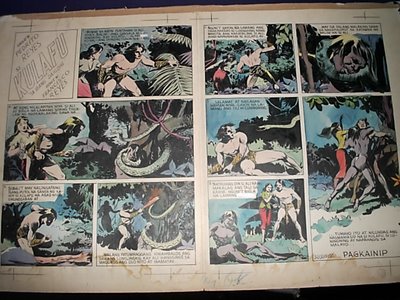 A contemporary of Tony Velasquez, Jose Zabala-Santos and J.M. Perez, Francisco Reyes great contribution to Philippine cartoon art is his immortal KULAFU. Of course, none of us younger geneartion living today will know that, because Kulafu existed only during the pre-war years of Philippine cartooning.
A contemporary of Tony Velasquez, Jose Zabala-Santos and J.M. Perez, Francisco Reyes great contribution to Philippine cartoon art is his immortal KULAFU. Of course, none of us younger geneartion living today will know that, because Kulafu existed only during the pre-war years of Philippine cartooning.
Influenced by Rice Borrough's Tarzan, Kulafu was the first ever cartoon strip to cover two whole pages of the Liwayway, and in full color! It was a very popular cartoon at that time, even competing with Kenkoy in terms of mass readership, yet after the war, Reyes surprisingly did not continue Kulafu, but instead created Talahib, another Tarzan-like character in the Halakhak Komiks. Yet despite his early demise, KULAFU will always be remembered as The Lord of the Philippine Jungles.
TO BE CONTINUED....

 Kenkoy, the first Filipino cartoon character, with his creator Tony Velasquez (aged 19) in the background, the recognized Father of the Tagalog Comics. (This is actually an old Kenkoy figurine doll from the collection of Tony Velasquez, and I placed his vintage picture from 1929 as a background)
Kenkoy, the first Filipino cartoon character, with his creator Tony Velasquez (aged 19) in the background, the recognized Father of the Tagalog Comics. (This is actually an old Kenkoy figurine doll from the collection of Tony Velasquez, and I placed his vintage picture from 1929 as a background)

